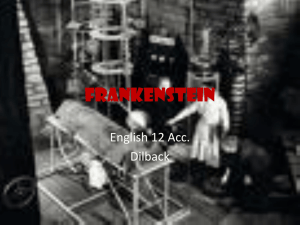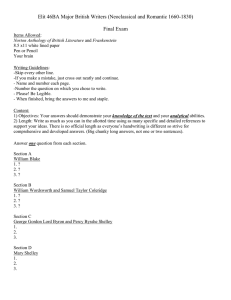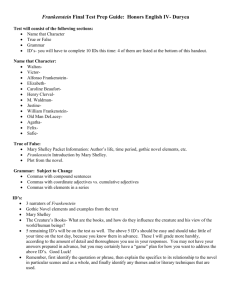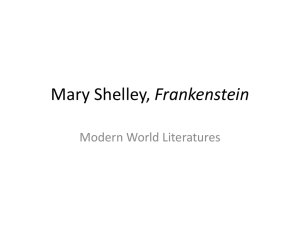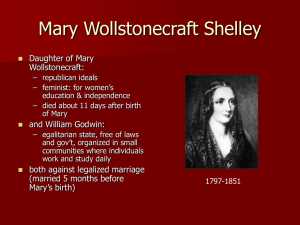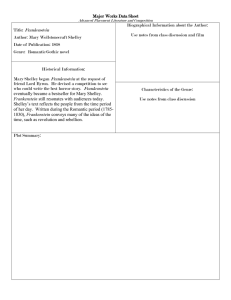Frankenstein – Mary Shelley Gothic Elements
advertisement
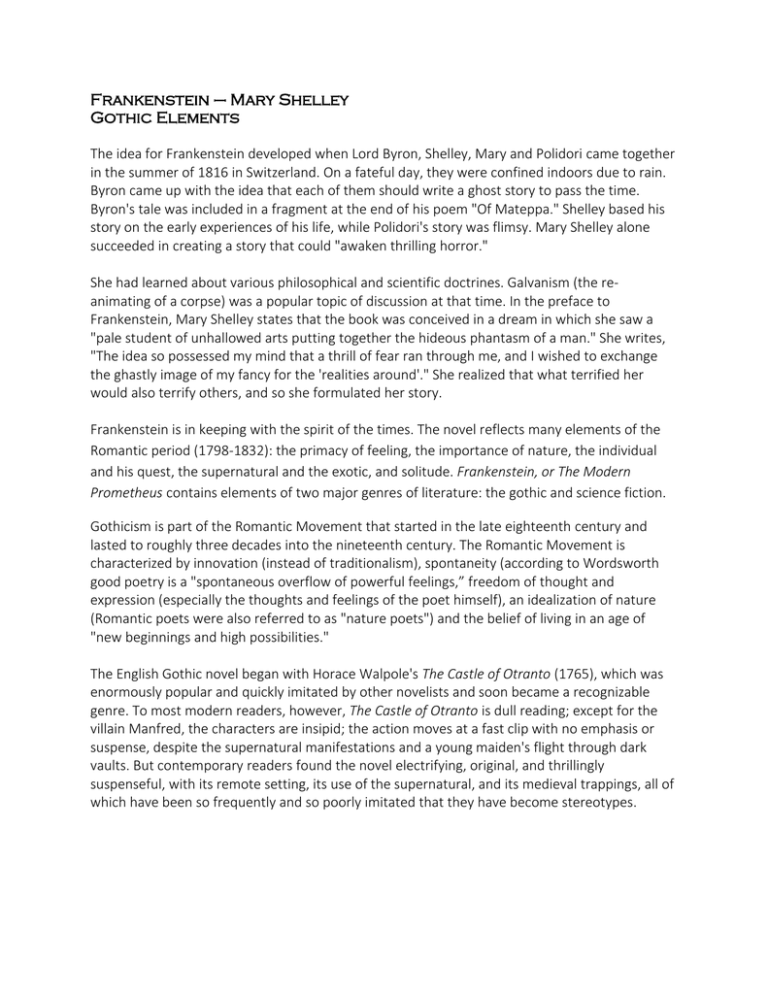
Frankenstein – Mary Shelley Gothic Elements The idea for Frankenstein developed when Lord Byron, Shelley, Mary and Polidori came together in the summer of 1816 in Switzerland. On a fateful day, they were confined indoors due to rain. Byron came up with the idea that each of them should write a ghost story to pass the time. Byron's tale was included in a fragment at the end of his poem "Of Mateppa." Shelley based his story on the early experiences of his life, while Polidori's story was flimsy. Mary Shelley alone succeeded in creating a story that could "awaken thrilling horror." She had learned about various philosophical and scientific doctrines. Galvanism (the reanimating of a corpse) was a popular topic of discussion at that time. In the preface to Frankenstein, Mary Shelley states that the book was conceived in a dream in which she saw a "pale student of unhallowed arts putting together the hideous phantasm of a man." She writes, "The idea so possessed my mind that a thrill of fear ran through me, and I wished to exchange the ghastly image of my fancy for the 'realities around'." She realized that what terrified her would also terrify others, and so she formulated her story. Frankenstein is in keeping with the spirit of the times. The novel reflects many elements of the Romantic period (1798-1832): the primacy of feeling, the importance of nature, the individual and his quest, the supernatural and the exotic, and solitude. Frankenstein, or The Modern Prometheus contains elements of two major genres of literature: the gothic and science fiction. Gothicism is part of the Romantic Movement that started in the late eighteenth century and lasted to roughly three decades into the nineteenth century. The Romantic Movement is characterized by innovation (instead of traditionalism), spontaneity (according to Wordsworth good poetry is a "spontaneous overflow of powerful feelings,” freedom of thought and expression (especially the thoughts and feelings of the poet himself), an idealization of nature (Romantic poets were also referred to as "nature poets") and the belief of living in an age of "new beginnings and high possibilities." The English Gothic novel began with Horace Walpole's The Castle of Otranto (1765), which was enormously popular and quickly imitated by other novelists and soon became a recognizable genre. To most modern readers, however, The Castle of Otranto is dull reading; except for the villain Manfred, the characters are insipid; the action moves at a fast clip with no emphasis or suspense, despite the supernatural manifestations and a young maiden's flight through dark vaults. But contemporary readers found the novel electrifying, original, and thrillingly suspenseful, with its remote setting, its use of the supernatural, and its medieval trappings, all of which have been so frequently and so poorly imitated that they have become stereotypes. A Gothic work often contains a combination of several of the following elements: a castle, ruined or intact, haunted or not, ruined buildings which are sinister or which arouse a pleasing melancholy, dungeons, underground passages, crypts, and catacombs which, in modern houses, become spooky basements or attics, labyrinths, dark corridors, and/or winding stairs, shadows, a beam of moonlight in the blackness, a flickering candle, or the only source of light failing (a candle blown out or an electric failure), extreme landscapes, like rugged mountains, thick forests, or icy wastes, and extreme weather, omens and ancestral curses, magic, supernatural manifestations, or the suggestion of the supernatural, a passion-driven, willful villain-hero or villain, a curious heroine with a tendency to faint and a need to be rescued–frequently, a hero whose true identity is revealed by the end of the novel, Science fiction explores "the marvels of discovery and achievement that may result from future developments in science and technology.” Mary Shelley used some of the most recent technological findings of her time to create Frankenstein. She has replaced the heavenly fire of the Prometheus myth with the spark of newly discovered electricity. The concepts of electricity and warmth led to the discovery of the galvanization process, which was said to be the key to the animation of life. Indeed, it is this process which animates Frankenstein's monster.
